Looking for some of the best Japanese matcha brands? There are several matcha brands online but you can never tell how authentic they are. So I’ve tried and tested a few Japanese matcha brands to find the best ones for you online.
Immerse yourself in the serene world of matcha with our selection of the best Japanese brands. Renowned for their rich history and meticulous cultivation techniques, these brands offer the finest ceremonial-grade matcha powders.
Savor the vibrant hues and exquisite umami flavors that embody the essence of traditional Japanese tea culture.
Which is the best Japanese matcha brand?
I’ve tried and tested over 10 matcha brands on Amazon based on color, flavor, aroma, source of tea leaves, and freshness. I found that Encha Matcha is the best Japanese matcha brand. Here's why:
Encha Matcha is a high-quality Japanese matcha brand with a smooth and balanced taste. It has almost no astringency when prepared with hot water. It is free of pesticide, synthetic fertilizers, GMO, and preservatives. The Encha Matcha powder is sourced directly from the farmers in the Uji mountains. It is USDA certified organic and is available on Amazon for $19.95
Best Japanese Matcha Brands: Quick Summary
| Best Japanese Matcha Brands | Known For |
| Encha Matcha | Encha ceremonial grade matcha powder |
| Soar Organics | Soar organics ceremonial matcha |
| Pure Matcha | Pure Matcha ceremonial matcha |
| Chalait Everyday | Chalait Everyday Ceremonial Grade Matcha |
| Ippodo Matcha | Ummon-no-mukashi |
| MatchaBar | Matcha Bar Classic Ceremonial grade matcha |
| Jade Leaf | Jade Leaf Organic Japanese Matcha |
Best Matcha Brands In Japan
Encha Matcha
Encha Matcha is one of my favorite Japanese matcha brands. This high-quality Japanese matcha brand is free of pesticide, synthetic fertilizers, GMO, and preservatives. I love this matcha brand because it has a smooth taste with almost no astringent after taste when you make it with hot water.
There are two varieties you can choose from - the ceremonial grade matcha and latte grade.
The ceremonial Grade Pure Organic Matcha powder is ground with the tender leaves of the first-harvest from the Uji Mountains of Kyoto.
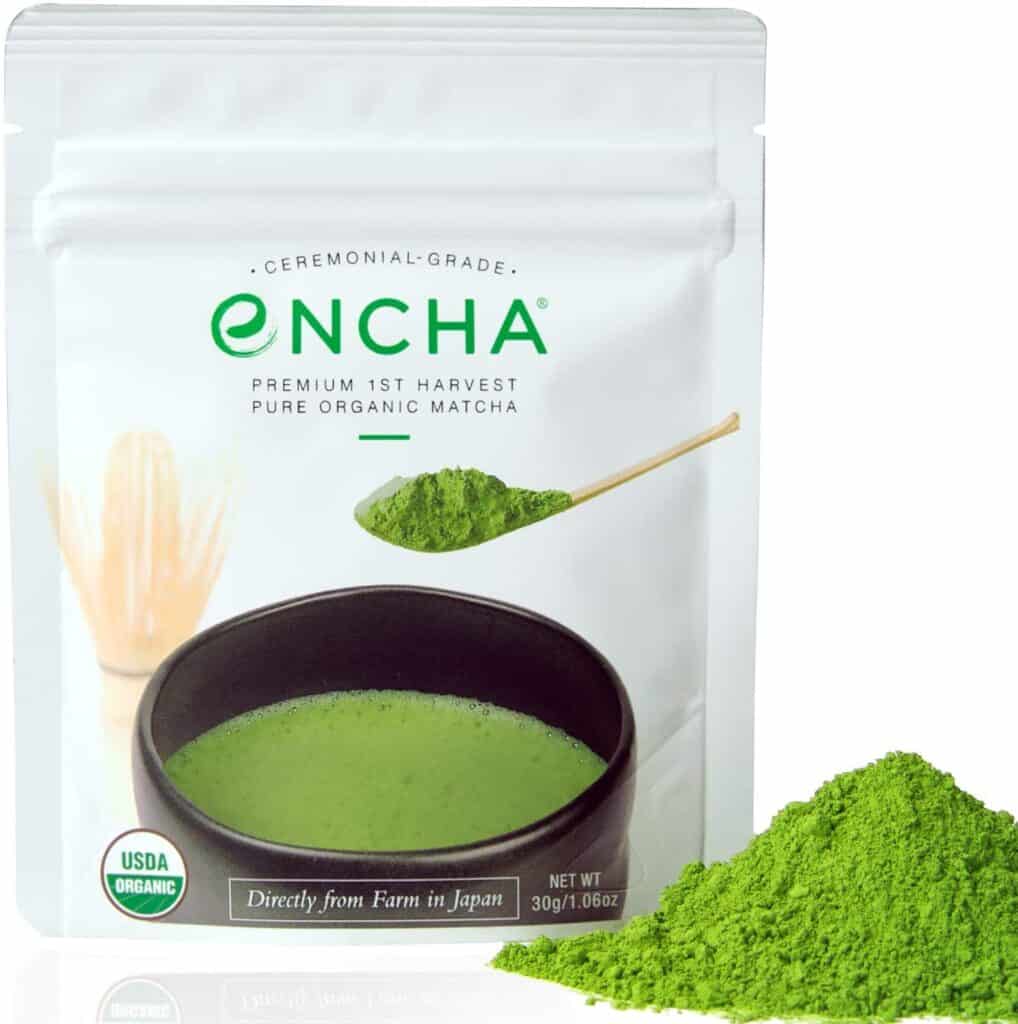
How to make:
Whist encha ceremonial matcha powder with 5oz hot water at 160F, vigorously to get enjoy a cup of full-bodied, smooth, and delicate cup of Japanese matcha green tea
This higher-quality Encha latte grade pure matcha is made from the first harvest of organic matcha grown in Kyoto’s Uji mountains. It’s high-quality is marked by it’s deep green and smoother taste when compared to other latte grade matcha.
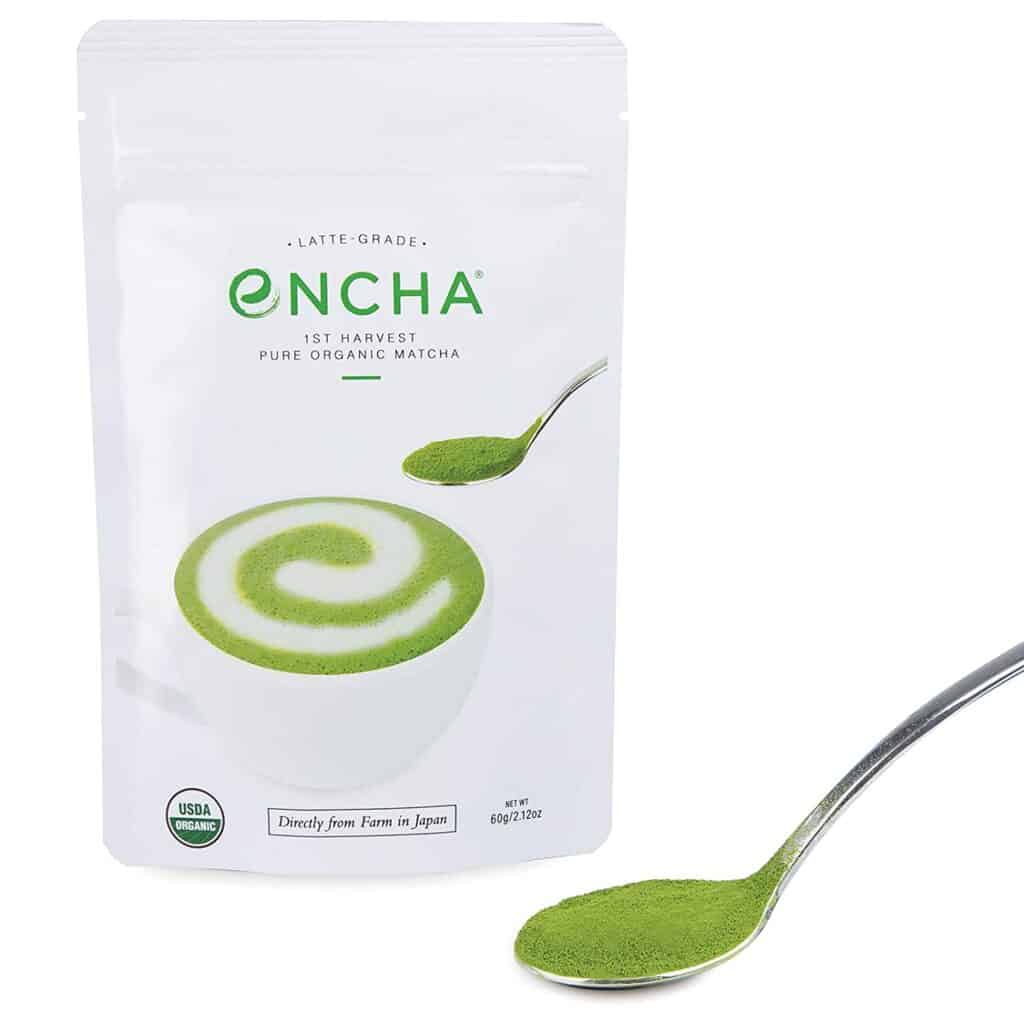
How to make:
It’s recommended you use a frother or matcha whisk when mixing to avoid clumps. Whisk 1tsp Encha latte grade matcha powder with 2oz of water. After that add milk accordingly.
All Japanese matcha powder offered by Encha is organic certified by the USDA.
Soar Organics
This Japanese matcha brand was launched in 2017 but I only recently had the chance to try it. The Soar organics ceremonial matcha has a vibrant green color when prepared and has a smooth taste. It is slightly sweet which I absolutely love!
The soar organics matcha powder is made by slowly stone grinding the first flush harvest in Kyoto. This Japanese matcha brand is certified by both Japanese agricultural organic standard and Canadian Organic Regime. It is also free of radiation, heavy metals and arsenic.
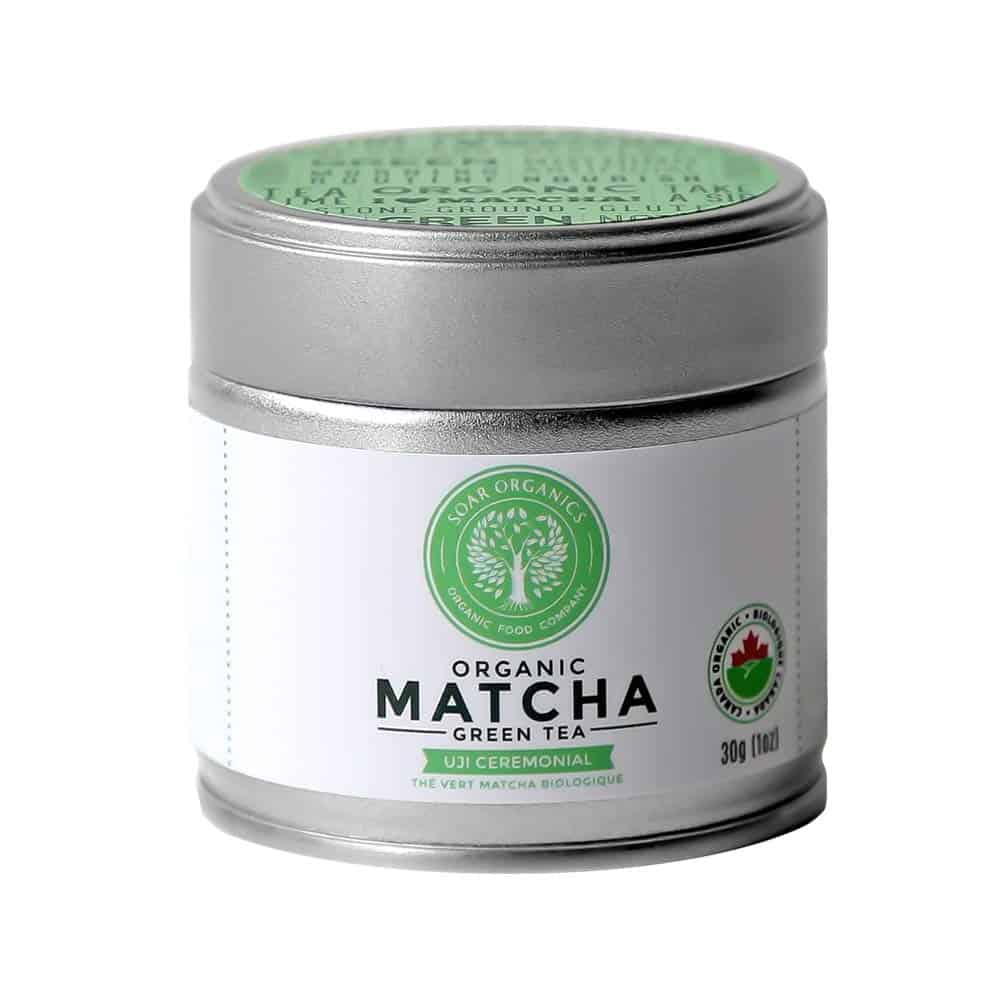
Why I, specially, have a soft spot for this Japanese matcha brand is because a portion of the sale made by any Soar Organic matcha is donated to the Canadian Feed the Children. So you can do your bit simply by buying delicious, healthy, organic Japanese matcha tea!
Check out this best Japanese matcha brands below!
Related: Mix these amazing Japanese collagen supplements with your morning tea to improve your skin, hair, and overall immunity!
Pure Matcha
Pure Matcha ceremonial green tea has fresh aroma and vibrant green color. This will quickly become your go-to matcha brand once you start drinking it as a rich, delicious buttery and smooth taste.
The premium ceremonial grade matcha powder is 100% pure, high-quality, organic matcha. Rich in antioxidants, matcha is packed with the goodness of catechins that boost immunity.
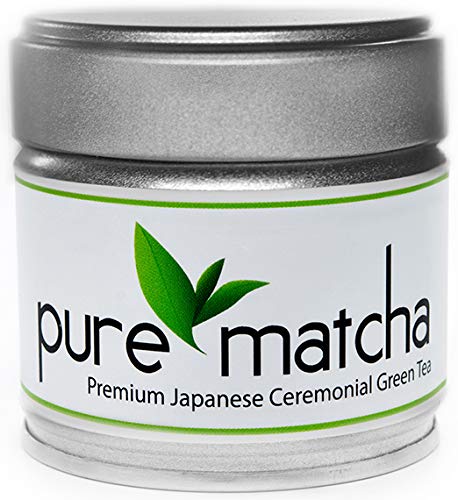
It also aids in weight loss as it boosts your metabolism 140 times more than regular green tea. It also blocks fat from breaking down and promotes absorption of fat by the cells so it passes through the body instead of being stored. It is also an appetite suppressant this helps you burn more calories and consume less.
How to make:
Use an electric or bamboo whisker to whisk the green tea. Alternatively, you can also use a blender. Since Pure Matcha is not instant matcha powder, you cannot mix it using a spoon.
Chalait Everyday Ceremonial Grade Matcha
Chalait Japanese matcha is harvested in Uji where you get the finest matcha in Japan. Hand-picked tea leaves of the first harvest in spring are ordered in small batches so you always receive fresh matcha powder.
Chalait sources matcha directly from the farmers of Uji to ensure highest quality premium grease matcha.
And you’ll recognise this high-quality with every sip of Chalait matcha. Chalait offers four varieties of flavor of ceremonial matcha - Everyday Grade Matcha, Organic Grade, Reserve Grade, Top Grade.
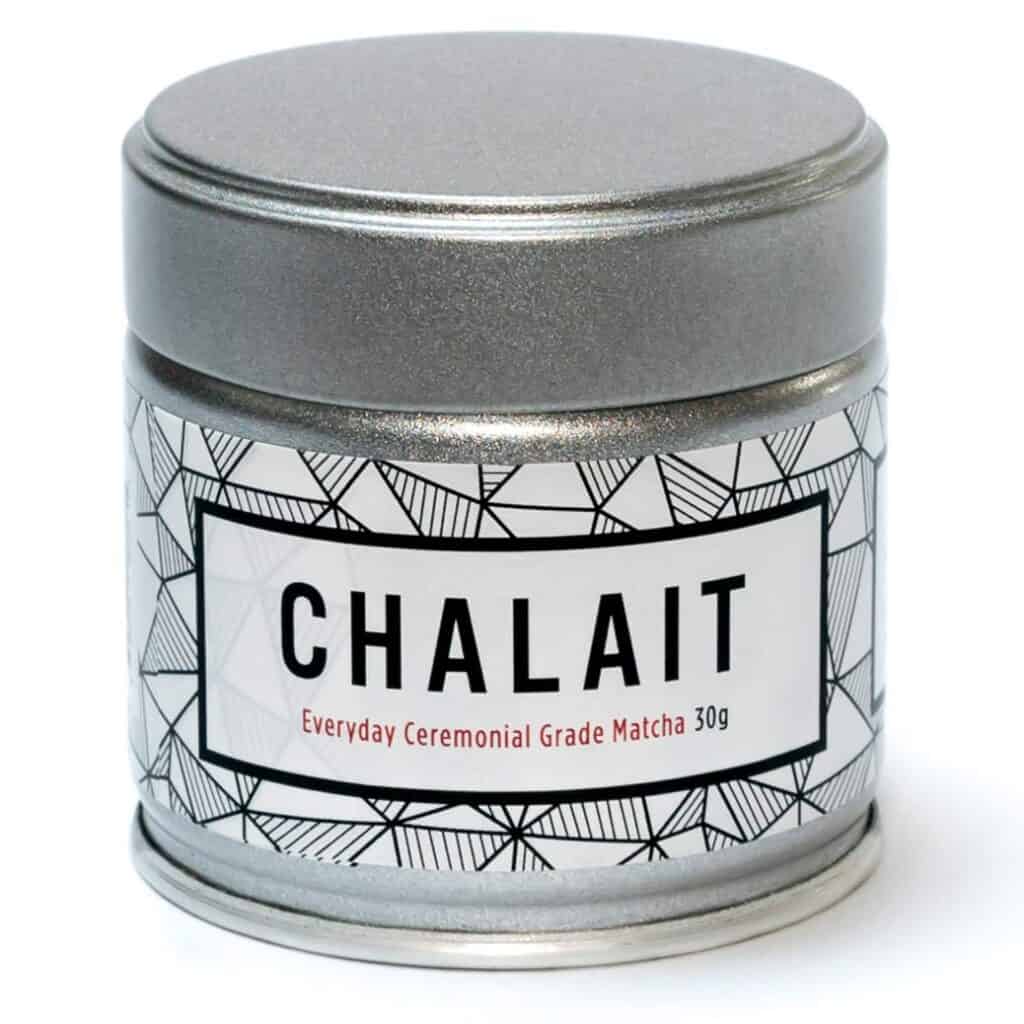
My favorite is the Everyday Ceremonial grade matcha. It has a mellow, smooth flavor with hints of cacao nibs, honeydew and bittersweet chocolate - absolutely delicious with complex flavor and rice aroma.
How to make:
The Chalait Everyday ceremonial grade matcha can be prepared to enjoy both matcha tea or matcha latte.
Top prepare matcha tea: Mix ½ tsp matcha with 2-3 o of hot water. Whisk it in W motion until you see thick frothy bubbles on the surface.
To prepare matcha latte: Simply add milk after preparing matcha tea
You can choose between the four flavors of this best Japanese matcha brands on Amazon below!
Ippodo Matcha: Ummon-no-mukashi
My favorite matcha from Ippodo matcha, one of the best Japanese matcha brands, is the Ummon-no-mukashi variant.
It has a full-bodied, rice flavor. The aroma is absolutely inviting and will definitely invigorate your mind and body. You can tell that it’s high quality by looking at its vibrant green emerald color and the fresh aroma.
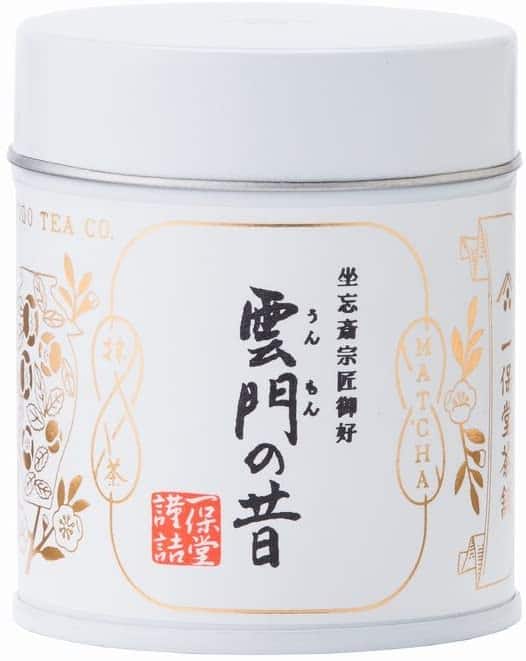
Launched in 1717, Ippodo tea has been supplying tea lovers with the highest quality of Japanese tea and has garnered a lot of love and appreciation for its flavor and the ultimate matcha experience it offers.
How to make:
Mix ½ tsp of matcha powder with water for matcha tea. And then mix milk for matcha latte. You can also add honey for added flavor.
Ippodo Tea offers other flavors and grade as well like Ikuyo matcha, Kan matcha, Sencha, Bancha.
MatchaBar Classic Matcha
The Matcha Bar Classic Ceremonial grade matcha is sourced from Kagoshima, Japan. It is rich in L-theanine and contains natural caffeine that helps you stay focused and calm through the day. You’ll feel energetic and focussed through the day, unlike coffee that only boosts energy for a few hours after consumption.
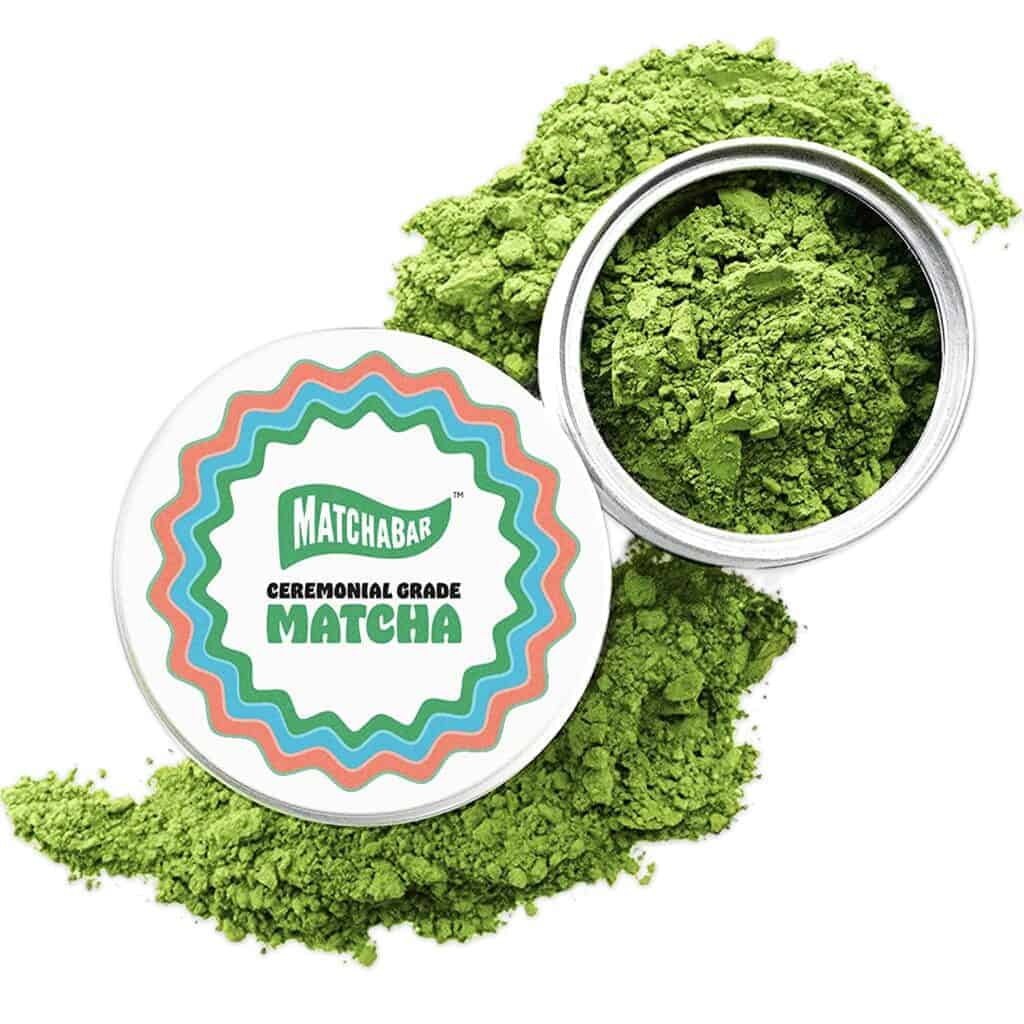
It has a smooth and balanced taste with an amazing green color, texture, and umami taste. It has an earthy, sweet taste which you’ll love! Directly sourced from kagoshima, MatchaBar orders small batches of matcha directly from the farmers to maintain its freshness and hand blends it. The matcha is graded by a certified Chasi tea master.
The matcha leaves are stone grounded that releases essential vitamins, micronutrients, and vitamins.
This best Japanese matcha brands also offers a 80 matcha powder tin. Other than that, you’ll also find Hustle Matcha Energy Drink in its Amazon store.
Related: Do you have the right Japanese rice to make authentic sushi? Find out which rice is the best for sushi and other Japanese dishes!
Jade Leaf Organic Japanese Matcha
Jade Leaf Organic Japanese Matcha is certified organic by USDA. Jade Leaf uses pure shade-grown green tea leaves. It is free of harmful fertilizers and pesticides. This Japanese matcha brand sources authentic Japanese matcha directly from family farms in Kagoshima and Uji.
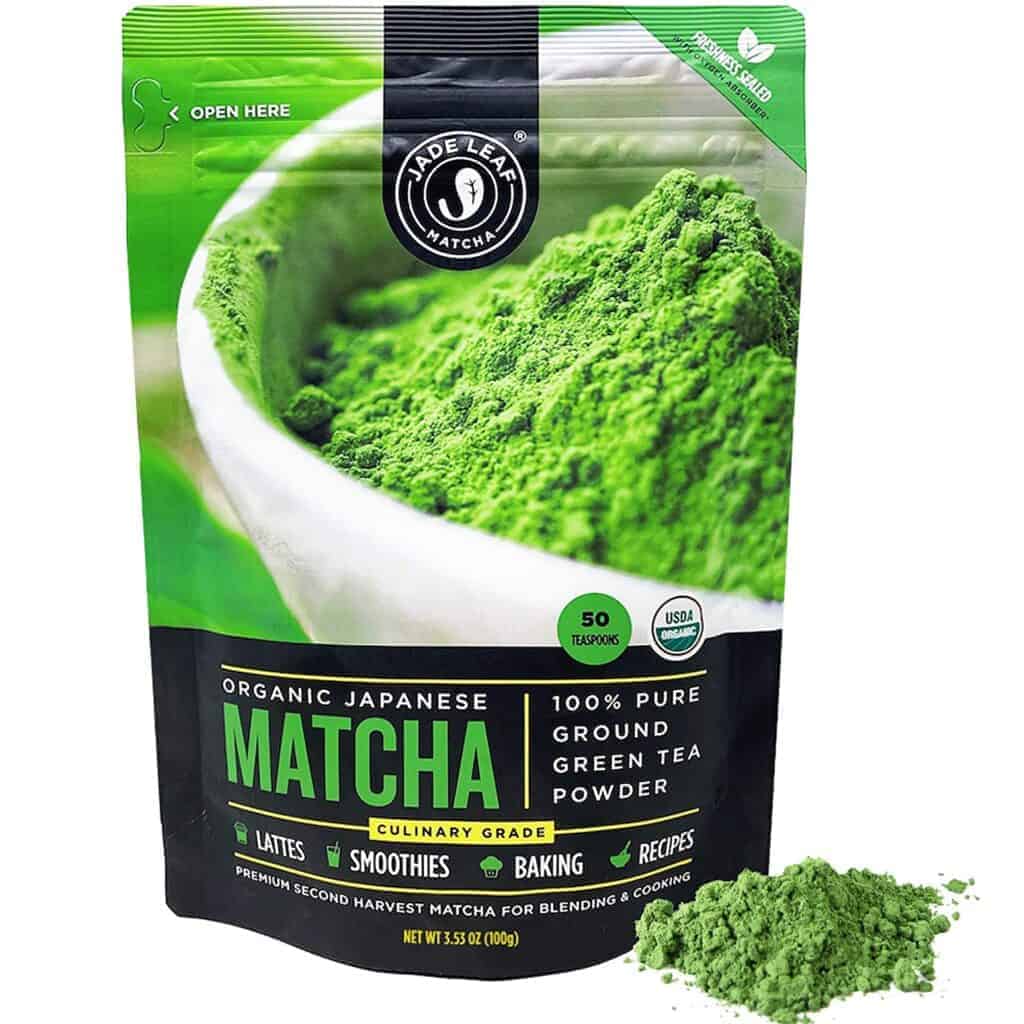
You can use Jade Leaf Organic Japanese Matcha powder to make tea, lattes, smoothies, and even mix it in baked good. It’s free of additives and is tested for heavy metals and other contaminants.
Find more products by JadeLeaf Matcha like single serve matcha sticks, matcha starter set, and matcha ceremony set below!
- Related: Best Japanese Green Tea
- Related: Popular Japanese Bottled Green Tea
Types Of Japanese Matcha
Matcha, a powdered green tea, is an integral part of Japanese tea culture. There are several types of matcha available, each with its unique characteristics. Here are some common types of Japanese matcha:
- Ceremonial Grade Matcha
This is the highest quality matcha, often used in traditional tea ceremonies. It is made from the youngest tea leaves, hand-picked and stone-ground into a fine powder. Ceremonial grade matcha has a vibrant green color, a smooth texture, and a delicate, sweet flavor.
- Premium Grade Matcha
This type of matcha is also high quality, but it may be slightly less vibrant in color and have a slightly stronger flavor compared to ceremonial grade matcha. Premium grade matcha is often used for daily consumption or in tea ceremonies where a slightly stronger taste is preferred.
- Culinary Grade Matcha
As the name suggests, culinary grade matcha is primarily used in cooking, baking, and blending into beverages like lattes and smoothies. It is made from more mature tea leaves, resulting in a slightly bitter taste. Culinary grade matcha is less expensive than ceremonial or premium grades, making it a popular choice for everyday culinary applications.
- Koicha Grade Matcha
Koicha is a thick and concentrated form of matcha used in a specific type of Japanese tea ceremony. It requires a higher grade of matcha with a milder flavor and a thicker consistency. Koicha grade matcha is typically more expensive and harder to find than other types.
- Usucha Grade Matcha
Usucha, meaning "thin tea," is the most common type of matcha used in daily consumption and tea ceremonies. It has a lighter consistency and is whisked into a frothy beverage. Usucha grade matcha offers a balance between flavor, aroma, and affordability.
- Organic Matcha
This refers to any type of matcha that is grown and processed using organic farming methods. Organic matcha is free from synthetic pesticides and fertilizers, making it a preferred choice for those seeking a more natural and environmentally friendly option.
It's worth noting that the quality and flavor of matcha can vary depending on factors such as growing conditions, processing methods, and the specific tea estate or region it comes from.
Each type of matcha has its own characteristics, allowing you to choose the one that suits your preferences and intended use.
How do you know if matcha is good quality?
To determine the quality of matcha, you can consider several factors. Here are some indicators of good-quality matcha:
- Color: High-quality matcha should have a vibrant, bright green color. It indicates that the leaves were carefully shade-grown and processed to preserve the vibrant green chlorophyll content.
- Aroma: Good matcha typically has a fresh, grassy, and slightly sweet aroma. The fragrance should be pleasant and inviting.
- Texture: When you rub the matcha between your fingers, it should feel smooth and silky, without any grittiness. Finely ground matcha powder is a characteristic of higher quality.
- Origin: Matcha from Japan is widely regarded as the best quality. Matcha produced in regions like Uji, Nishio, and Shizuoka in Japan are known for their high-quality tea production.
- Grade: Matcha is often graded based on its quality. Ceremonial grade matcha is considered the highest quality and is typically used in traditional tea ceremonies. Culinary grade matcha is of lower quality but still suitable for various culinary uses like baking or smoothies.
- Packaging: Matcha that is packaged in airtight, light-blocking containers helps preserve its freshness and vibrant color. Quality matcha is often sold in sealed tins or resealable bags to protect it from moisture and oxidation.
- Taste: High-quality matcha has a rich, smooth, and slightly sweet flavor. It should have a balanced umami taste without any bitterness or astringency.
What is the best matcha to try for beginners?
For beginners, try a ceremonial-grade matcha with a mild flavor profile. Look for brands offering affordable options like Ippodo Tea's Horai or Rishi Tea Matcha Powder. These are gentle introductions to the world of matcha without breaking the bank.
Best Japanese Matcha Brands: FAQs
Which part of Japan makes the best matcha?
The Uji region of Kyoto Prefecture is considered to be the birthplace of matcha, and it is still widely regarded as the best place to produce matcha in Japan. The area has a long history of matcha production, dating back to the 12th century.
The soil in Uji is ideal for growing tea plants, and the climate is also well-suited for matcha production. The tea leaves grown in Uji are known for their high quality and their rich, umami flavor.
What is the highest grade matcha?
The highest grade of matcha is ceremonial grade. It is made from the youngest and most tender tea leaves, which are grown in the shade for several weeks before being harvested. The leaves are then steamed and ground into a fine powder. Ceremonial grade matcha has a vibrant green color, a smooth texture, and a rich, umami flavor.
It is typically used for traditional Japanese tea ceremonies, but it can also be enjoyed in a variety of other ways, such as in smoothies, lattes, and baked goods.
Why Japanese matcha is expensive?
There are several reasons why Japanese matcha is expensive.
- The growing process is labor-intensive and time-consuming. Matcha is made from the youngest and most tender tea leaves, which are grown in the shade for several weeks before being harvested. This process is called chadawari, and it is essential for producing high-quality matcha. The leaves are then steamed and ground into a fine powder, which is also a labor-intensive process.
- The best matcha only comes from a few specific regions in Japan. The Uji region of Kyoto Prefecture is considered to be the best place to produce matcha in Japan. The soil in Uji is ideal for growing tea plants, and the climate is also well-suited for matcha production. The tea leaves grown in Uji are known for their high quality and their rich, umami flavor.
- There is a high demand for Japanese matcha. Matcha has become increasingly popular in recent years, both in Japan and around the world. This has led to an increase in demand for Japanese matcha, which has put upward pressure on prices.
As a result of these factors, Japanese matcha is generally more expensive than other types of tea.
However, the high price is justified by the quality and taste of Japanese matcha. If you are looking for the best matcha in the world, then you should definitely consider Japanese matcha.
Why is Uji Matcha famous?
Uji Matcha is famous for a number of reasons, including:
- The quality of the tea leaves: The tea leaves grown in Uji are known for their high quality. The soil in Uji is ideal for growing tea plants, and the climate is also well-suited for matcha production.
- The traditional production methods: Uji Matcha is produced using traditional methods that have been passed down for centuries. These methods ensure that the matcha is of the highest quality.
- The unique flavor: Uji Matcha has a unique flavor that is different from other types of matcha. It is said to be more umami and less bitter.
- The history: Uji has a long history of matcha production. It is said that matcha was first introduced to Uji by Zen Buddhist monks in the 12th century.
As a result of these factors, Uji Matcha is considered to be one of the best types of matcha in the world. It is often used in traditional Japanese tea ceremonies, and it is also becoming increasingly popular around the world.
Here are some of the specific reasons why Uji Matcha is considered to be the best:
- The soil: The soil in Uji is rich in minerals and nutrients, which gives the tea leaves their unique flavor.
- The climate: The climate in Uji is mild and humid, which is ideal for growing tea plants.
- The harvesting method: The tea leaves in Uji are harvested in the shade for several weeks before being processed. This process gives the leaves a higher concentration of chlorophyll and L-theanine, which are two of the compounds that give matcha its unique flavor and health benefits.
- The grinding method: The tea leaves in Uji are ground into a fine powder using traditional methods. This process ensures that the matcha retains its nutrients and flavor.
If you are looking for the best matcha in the world, then you should definitely consider Uji Matcha. It is a delicious and nutritious beverage that is worth the investment.
Is Japanese matcha good?
Japanese matcha is considered to be one of the best types of matcha in the world. It is made from the highest quality tea leaves, which are grown in the shade for several weeks before being harvested. The leaves are then steamed and ground into a fine powder.
Japanese matcha has a vibrant green color, a smooth texture, and a rich, umami flavor. It is also a good source of antioxidants and other nutrients.
Why is Japanese matcha so expensive?
Matcha is expensive because of it’s growing and production. It requires a lot of labour and is time consuming. Most of the matcha are manually powdered through ground stone or other traditional methods that require manual labours.
Is it safe to drink matcha everyday?
Yes, you can drink matcha everyday. However, it’s not advisable to drink more than 2 cups of matcha per day.
Is matcha good for weight loss?
Matcha is beneficial to drink between 1 to 4 tbsp. It helps in losing approximately 3 lbs in 12 weeks with no diet or activity changes. It helps in decreasing body fat composition and abdominal fat as well.
Also Read:




Comments (0)
There are no comments for this article. Be the first one to leave a message!